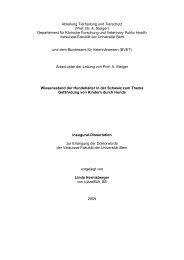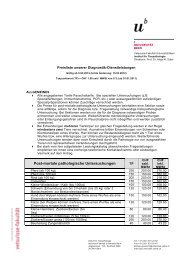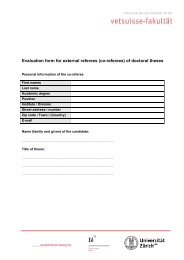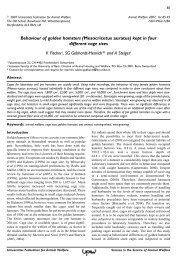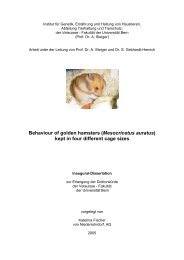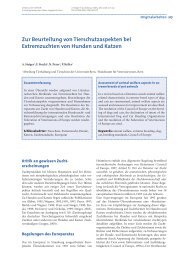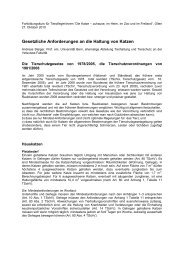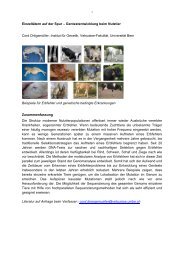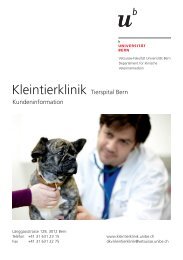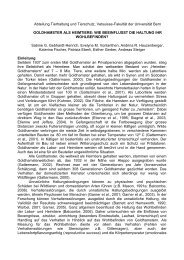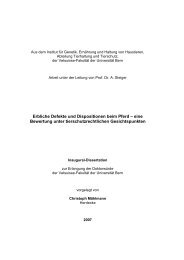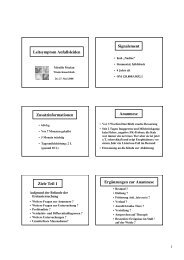Create successful ePaper yourself
Turn your PDF publications into a flip-book with our unique Google optimized e-Paper software.
1) Baylis (2009) 2) Zweifel (2010)Institute for Food Safety and HygieneSTEC in raw milk cheese• Cheese production in Switzerland: about 180 t per year• Large proportion of Swiss cheese made from raw milk−−Enhanced flavor characteristicsBut: a specific hazard is STEC• Raw milk cheese associated STEC outbreaks were reported 1• STEC prevalence in raw milk cheese in Switzerland− Detection rate (PCR): 5.7 % of 1‘502 raw milk cheese samples 2
Institute for Food Safety and HygienePreliminary experiments• Characterization of 41 E. coli strains isolated from raw milk cheese−−General characteristics and cheese-related stress responseFound 8 strains showing increased heat resistance• Heat resistance in raw milk during thermisation treatment−Close to commercial conditions (pilot-plant-pasteurizer)− Considerable thermotolerance of certain strains (up to D 67.5 = 47.1 ± 8.1 s)⇒ Selection of strains for cheese spiking experiments
Institute for Food Safety and HygieneFate of E. coli in semi-hard model raw milk cheese• Cooperation with Max Rubner-Institut Kiel, Germany• Spiking with three STEC and two generic E. coli strains• Sampling during production and ripening• BUT: biosafety restrictions due to the use of STECDifferences to typical Swiss cheese⇒ atypical rectangular shape⇒ small cheese mass (about 2.5 kg)⇒ wax coating instead of smear
Institute for Food Safety and HygieneFate of E. coli in semi-hard model raw milk cheeseSpike 10 1 CFU/g• Spiking of raw milk prior to cheese making(app. 10 1 and 10 3 CFU/g)• Increase during production(concentration effect and growth)• Significant differences in reduction duringripening between strains⇒ Generic E. coli strains survived ratherbetter than STEC strains⇒ At the end of ripening still considerable numbers of E. coli in most cheeses
1) Ross (2008)Institute for Food Safety and HygieneDifference in reduction rate between rind and core• At growth-preventing conditions reduction rate proposed to mainly depend on temperature 1• Water activity and pH only minor differences between rind and core• Temperature in ripening chamber remains constant• Gradient in carbon dioxide as causative factor?−Higher partial pressure of CO 2 in core than in rind leading to faster inactivation?• Outermost edible part the most favorable zone for survival of E. coli?
Institute for Food Safety and HygieneHard raw milk cheese (Spike: app. 10 3 CFU/g)• FAM21843 K303• Only rind samples taken• Temperature profile reflects „worst-case“scenario for survival of E. coli⇒ Thermotolerant strain less reduced during cooking⇒ Both strains almost completely inactivated at day 1⇒ Detection by enrichment possible in few samples during ripening
Institute for Food Safety and HygieneSummary E. coli in Swiss raw milk cheese• Physical and chemical parameters as expected in semi-hard and hard cheese⇒Production and ripening of cheese not affected by E. coli• Considerable numbers of E. coli at the end of semi-hard cheese ripening• Risk for survival of E. coli considerably lower in hard than in semi-hard cheese• Further investigations on increased thermotolerance of E. coli⇒ Analysis of gene expression from „thermotolerance region“ during stress conditions
Institute for Food Safety and HygieneLast but not least? Thanks to the co-workers atILS, ALP and MRI Kiel thatcontributed to the projectYou are invited to askquestions



